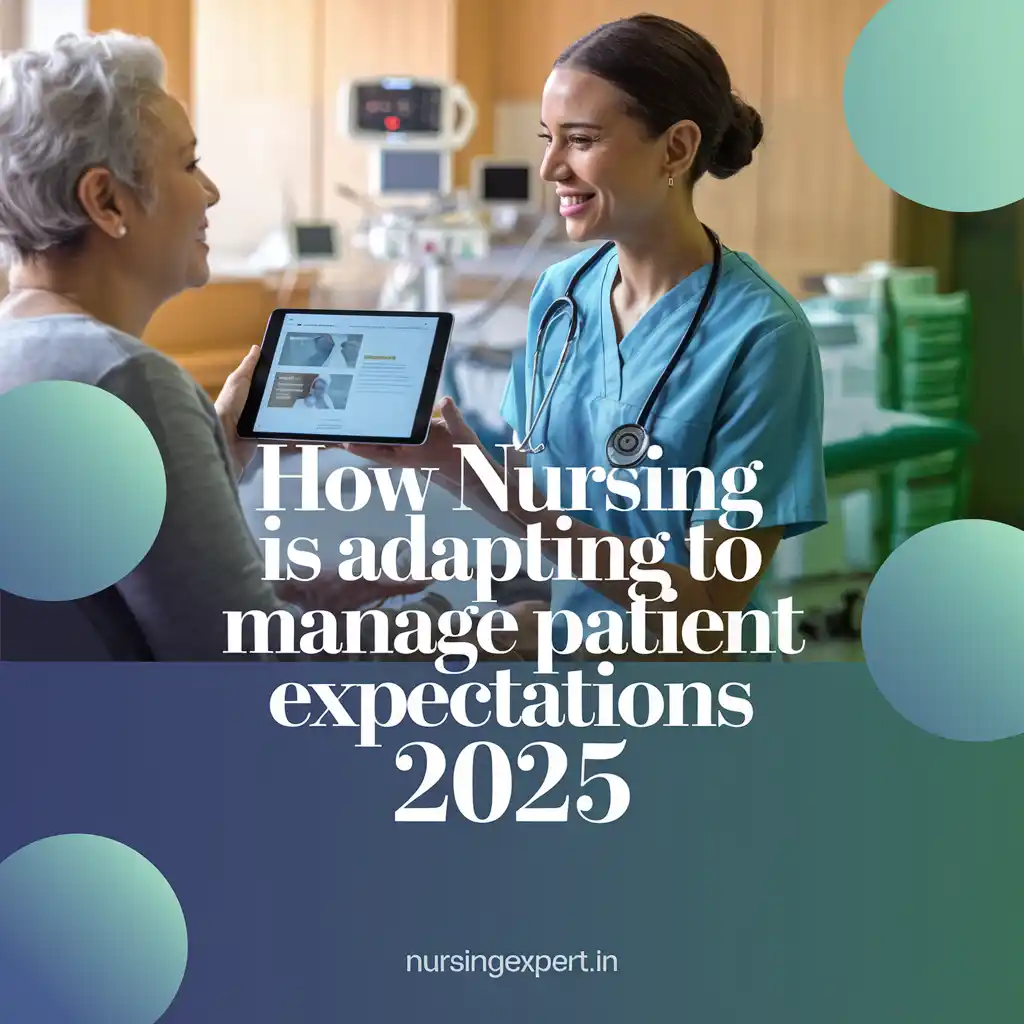How to Manage Patient Expectations in Nursing: Patient expectations play a critical role in shaping the overall healthcare experience. In 2025, as healthcare becomes increasingly patient-centered and complex, managing these expectations is a key competency for nurses. Successfully aligning patients’ expectations with realistic outcomes can improve satisfaction, foster trust, and ultimately lead to better health outcomes. By employing a holistic approach that combines empathy, clear communication, and continuous education, nurses can ensure that patients are informed, empowered, and engaged in their care.
Thank you for reading this post, don't forget to subscribe!
Introduction
Healthcare today is evolving rapidly, and patients come into the care process with high expectations. These expectations may include quick responses to their concerns, detailed information about their conditions, and personalized treatment plans. However, not all expectations are realistic, and discrepancies between what patients anticipate and the actual care delivered can lead to dissatisfaction and stress for both patients and providers. In this environment, it is essential for nurses to manage expectations effectively to create a collaborative, patient-centered atmosphere.


In 2025, managing patient expectations goes beyond the clinical encounter—it involves clear communication, fostering trust, educating patients, and advocating for realistic outcomes. Nurses serve as the bridge between high-level clinical decisions and patient perceptions, ensuring that every interaction contributes positively to the patient experience.
Understanding Patient Expectations
a. What Patients Expect from Their Care
Patients generally expect:
- Clear Communication: They want understandable explanations about their diagnosis, treatment options, and care plans.
- Timely Responses: Quick and prompt attention to their needs is critical.
- Compassionate Interaction: Empathy, respect, and genuine care are highly valued.
- Personalized Care: Patients appreciate care that considers their unique circumstances, including cultural, social, and personal factors.
- Transparency: Being informed about potential risks, outcomes, and any changes to their care plan.
b. The Impact of Misaligned Expectations
When expectations are not met, patients may feel frustrated or distrustful, which can adversely affect:
- Adherence to Treatment: Patients might not follow through with care if they feel their expectations are unfulfilled.
- Patient Satisfaction: Inadequate communication or unmet promises can decrease overall satisfaction.
- Healthcare Outcomes: Mismatched expectations may lead to delays in care, reduced engagement, and poorer health outcomes.
Understanding patient expectations is the first step in effectively managing them. Nurses must recognize that while patients may sometimes have unrealistic hopes, clear and open dialogue can help bridge the gap between expectation and reality.
Strategies for Managing Patient Expectations
a. Establishing Clear Communication
i. Active Listening and Empathy
- Listen carefully to patients’ concerns and acknowledge their feelings.
- Use empathetic language to build trust and demonstrate understanding.
ii. Plain Language and Visual Aids
- Avoid medical jargon; explain conditions and procedures in simple, relatable terms.
- Use diagrams, charts, and videos to illustrate complex information.
iii. Consistent Messaging
- Ensure that all members of the healthcare team provide consistent information.
- Use standardized tools and protocols, such as SBAR (Situation, Background, Assessment, and Recommendation), to maintain clarity across shifts and departments.
b. Involving Patients in Their Care
i. Shared Decision-Making
- Encourage patients to ask questions and participate in care planning.
- Discuss realistic outcomes and set achievable goals together.
ii. Education on Care Processes
- Provide detailed explanations about what patients can expect at each stage of their care.
- Distribute easy-to-understand written materials and offer digital resources for additional learning.
c. Setting Realistic Goals
i. Transparent Discussions
- Clearly communicate possible outcomes, including limitations and potential challenges.
- Discuss what is achievable based on the patient’s condition, resources, and the clinical situation.
ii. Short-Term and Long-Term Goals
- Establish both immediate and future goals that are specific, measurable, and attainable.
- Regularly review and adjust goals as care progresses and patient conditions change.
d. Leveraging Technology
i. Digital Health Tools
- Utilize telehealth platforms for remote follow-ups and ongoing communication.
- Use patient portals where individuals can access their health records, educational materials, and progress reports.
ii. Interactive Apps and Virtual Education
- Provide access to mobile apps that offer personalized health education, reminders, and interactive tools to better understand their care plan.
- Engage patients with virtual workshops or webinars that explain their condition and the rationale behind treatment decisions.
e. Fostering a Supportive Environment
i. Build Trust and Rapport
- Create a welcoming and respectful environment in which patients feel comfortable sharing their concerns.
- Establish continuity of care by ensuring that patients see familiar faces and have a consistent support team.
ii. Engage Family and Caregivers
- Involve family members or caregivers in the education and decision-making process.
- Provide joint consultations where possible to ensure that caregivers also understand the care plan and can support the patient at home.
Addressing Challenges in Managing Patient Expectations
a. Overcoming Miscommunication
- Frequent Check-Ins: Regularly verify understanding by asking patients to repeat key information.
- Tailored Education: Customize educational approaches to accommodate different learning styles and literacy levels.
b. Balancing Optimism with Realism
- Honest Conversations: While it is important to be positive, nurses must also be honest about potential limitations and realistic outcomes.
- Transparency about Uncertainties: Acknowledge any uncertainties in prognosis or treatment, and explain the steps being taken to monitor and adapt care.
c. Dealing with Diverse Cultural Perspectives
- Culturally Sensitive Communication: Understand and respect cultural differences that may influence a patient’s expectations.
- Language and Translation Services: Use interpreters and provide materials in multiple languages to ensure clarity and inclusivity.
d. Integrating Technology Effectively
- Overcoming Digital Barriers: Recognize that not all patients are comfortable with digital tools and provide additional assistance or alternatives when necessary.
- Continuous Training: Ensure that nurses are well-trained in using telehealth platforms and digital communication tools, so they can support patients confidently.
Future Trends in Managing Patient Expectations
a. Expansion of Telehealth and Virtual Care
- Enhanced Virtual Interactions: As telehealth evolves, virtual consultations will become more immersive and interactive, improving patient engagement and satisfaction.
- Remote Monitoring Integration: Combining telehealth with remote monitoring devices will provide real-time updates that can help manage patient expectations more effectively.
b. AI-Driven Personalization
- Predictive Analytics: Advanced AI will forecast patient outcomes and tailor educational content based on individual data, enabling more precise setting of expectations.
- Customized Communication: AI tools may personalize how information is delivered, ensuring that messages are pitched at the right level for each patient.
c. Broader Interprofessional Collaboration
- Integrated Care Teams: Greater collaboration among healthcare professionals will ensure that all aspects of care are communicated clearly to the patient.
- Shared Education Initiatives: Joint patient education efforts across disciplines will foster a unified message and more consistent care experiences.
d. Policy and Organizational Support
- Standardized Guidelines: Future policies may emphasize standard protocols for managing patient expectations, reducing variability in care.
- Increased Funding: Investment in digital health infrastructure and professional development will support the ongoing shift towards personalized, patient-centered care.
Frequently Asked Questions (FAQs)
Q1: Why is managing patient expectations important in nursing?
A: Managing patient expectations improves satisfaction, reduces misunderstandings, and leads to better adherence to treatment plans, ultimately enhancing health outcomes.
Q2: How do nurses help patients understand their care?
A: Nurses use clear communication, personalized education, visual aids, and digital tools to simplify complex information and engage patients in shared decision-making.
Q3: What role does technology play in patient education and expectations management?
A: Technology—through telehealth, patient portals, and mobile apps—provides accessible, interactive, and personalized educational resources, helping patients stay informed and engaged in their care.
Q4: How can nurses ensure that patients have realistic expectations?
A: By having honest, transparent conversations about the likely outcomes, involving patients in care planning, and continuously updating them on progress and any changes in their treatment plans.
Q5: What challenges might nurses face when managing patient expectations?
A: Challenges include communication barriers, cultural differences, digital literacy issues, and the need to balance optimism with realistic outcomes in care.
Q6: How can interdisciplinary teams enhance the management of patient expectations?
A: Collaborative care involves sharing consistent information across all healthcare providers, ensuring that patients receive a unified message that addresses all aspects of their health, leading to more coordinated and effective care.
Q7: What future trends may further improve patient expectations management in nursing?
A: Future trends include the integration of AI for personalized education, expanded telehealth services, enhanced digital health tools, and stronger interprofessional collaboration, all contributing to a more patient-centered approach.
Conclusion
Managing patient expectations is essential in the modern healthcare landscape, especially as care becomes more personalized and technology-driven. In 2025, nurses are leading the charge by adopting innovative strategies that combine clear communication, digital tools, and interprofessional collaboration. By setting realistic goals, engaging patients and their families in the care process, and continuously adjusting education based on feedback and data, nurses ensure that patients are well-informed and empowered.
This human-centered approach not only enhances patient satisfaction but also improves health outcomes by fostering trust, adherence, and active participation in care. As technology continues to evolve, the opportunities for personalized, AI-driven patient education will expand, further enabling nurses to meet and exceed patient expectations. The future of healthcare lies in a collaborative, transparent, and adaptive system—one where nurses play a pivotal role in aligning care delivery with the needs and values of every individual.
References and Sources
- American Nurses Association (ANA). (2023). Patient Education: Strategies and Best Practices. Retrieved from https://www.nursingworld.org
- Centers for Disease Control and Prevention (CDC). (2024). Health Literacy and Patient Education. Retrieved from https://www.cdc.gov/healthliteracy
- Journal of Nursing Education. (2024). Innovations in Patient-Centered Communication. Retrieved from https://journals.lww.com/jne
- Institute for Healthcare Improvement (IHI). (2022). Improving Patient Engagement Through Digital Health. Retrieved from https://www.ihi.org
- Peer-reviewed articles from the International Journal of Medical Informatics and Telemedicine and e-Health.
- Additional resources from the World Health Organization (WHO) and policy briefs on digital health in patient care.


